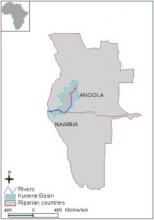Main informations

Basic data
Website
Geographical scope
The Kunene River Basin (not specifically stated, but often referred to in the agreements).
| Countries | Area |
|---|---|
|
Angola
|
95300km²
|
|
Namibia
|
14900km²
|
Function/mandat
In 1969 the Permanent Joint Technical Committee was established as an advisory body to study and report on matters relating to the general agreement on the development of the water resources of the basin. It was particularly instructed to oversee the implementation of development projects on the river encompassing the construction of three dams, a power station, and a pumping station. The mandate was renewed in the agreement of 1990.
Organisation
The main organ is the Permanent Joint Technical Commission (PJTC).
The Permanent Joint Technical Commission (PJTC) is an advisory body established to consult the respective governments on the development of the Kunene River and to oversee the implementation of List of common infrastructure projects.
The 1969 Agreement defined the activities of the first phase of development as construction of a dam at Gove in Angola to regulate the flow of the Kunene River, construction of a dam at Calueque upstream the Ruacana Falls for further regulation of the river and to meet the requirements of the power station at Ruacana falls and a pumping station at Calueque for irrigation purposes and construction of the Matala dam in Angola. The Calueque-Ruacana Scheme was never completed and partly destroyed during the Angolan civil war. The Gove dam was also damaged. In 1990 it was agreed to repair the dams. Currently, development of the Epupa hydroelectric scheme at the Epupa Waterfall is being pursued. The 1990 agreement revitalizing the development works on the Kunene provided for the set up of a Joint Operating Authority to ensure the maximum beneficial regulation at Gove that is needed for optimum power generation at Ruacana and to control the withdrawal of water along the middle reaches of the Kunene. The Authority was also expected to ensure the continuous operation and maintenance of the water pumping works at Calueque and the diversion weir at Ruacana.
No special provisions on monitoring and information were provided in the agreements.
In the PJTC decisions, four members form a quorum, provided that at least two members of each delegation are present. Decisions are taken unanimously. If the Commission fails to reach a decision, the dispute is referred to the Governments for negotiation.
Each government is responsible for the expenses of its own delegation. Joint expenses are shared equally by the two Governments.
No specific provisions
The first transboundary cooperation in the Kunene River Basin dates as far back as 1926 when South Africa and Portugal signed an agreement to regulate the use of the water of the Kunene River for the purposes of generating power, flood prevention, and irrigation. No infrastructure developments were undertaken until 1969 when an agreement was reached to build three dams to regulate the river and generate power. The development was overseen by the Permanent Joint Technical Commission established with the 1969 Agreement. In 1975 a civil war broke out immediately after Angola had gained independence. The Ruacana-Calueque project was not completed and severely damaged during the conflict. Angola and Namibia, after its independence in 1990, agreed to reactivate agreements from 1969 and to repair the damaged dams. Two agreements were signed. The first agreement concerned the completion of the planned dams and power plants along the Kunene and the development of future schemes in order to secthe countries future needs for electricity. The second one concerned general cooperation between the countries and established the Angolan-Namibian Joint Commission of Co-operation. The Joint Commission of Cooperation deals with joint cooperative efforts on a number of issues, one of which is water.
Legal basis
| Date | Treaty name | Signatories |
|---|---|---|
|
1926-07-01
|
Curene Water Use Regulation
|
Portugal
South Africa
|
|
1931-04-29
|
Angola/S.Africa Boundary Notes
|
Portugal
South Africa
|
|
1969-01-21
|
Water Resource Development
|
Portugal
South Africa
|
|
1996-07-01
|
Joint Water Commission Terms of Reference
|
Mozambique
South Africa
|
|
2001-10-01
|
Completion/Expansion of Water Supply Memorandum
|
Angola
Nambia
|
Challenges
Arid river catchment, commitment of water to irrigation in Namibia, inter-basin/ inter-state water transfer, environmental/social impediments to hydropower development, different levels of development and limited PJTC mandate.
 AWIS/Sadieau
AWIS/Sadieau